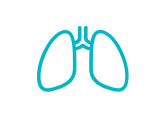CAUSES OF OPIOID OVERDOSE
An overdose can happen to anyone who takes opioids. A person is more likely to overdose if they:
- Take opioids with other drugs or alcohol
- Take opioids that are not prescribed to them, or they take more than prescribed
- Stop taking opioids for a while, then start taking them again
- Have heart or lung disease
When someone overdoses, their breathing will get very slow and may stop. They may look like they are sleeping and their lips and fingernails may appear pale, blue, or gray. An overdose can happen suddenly or come on slowly over the course of a few hours. Without oxygen, the result can be fatal.
RESPONDING TO AN OVERDOSE
Stay with the person until help arrives (and about two hours after the overdose)

Check for signs of opioids

Call 911
![]()
Give naloxone

Perform rescue breaths

Stay with the person until help arrives (and two hours after the overdose)
WHAT IS NALOXONE?
Naloxone (or Narcan) is a prescription medicine that reverses an opioid overdose by blocking the opioid receptors in the brain. It helps a person begin breathing again and wake up from an overdose. Naloxone (or Narcan) cannot be used to get high and it is not addictive. It can be easily and safely administered by anyone. First responders often carry Naloxone (or Narcan).
SIGNS OF AN OVERDOSE MAY INCLUDE
SLOW OR NO
BREATHING.WON'T WAKE UP.
PALE, ASHY, COOL
SKIN.BLUE LIPS OR
FINGERNAILS.
GOOD SAMARITAN LAWS
A Good Samaritan Law protects both the person helping and the person experiencing an overdose from liability or drug possession charges. Washington State has a Good Samaritan Law and Tribes are starting to pass similar laws. See how Tribes are implementing Good Samaritan Laws in Indian Country.
START A NALOXONE PROGRAM
For more information on how your Tribe can start a Naloxone program, read the Starting a Naloxone Program Fact Sheet


